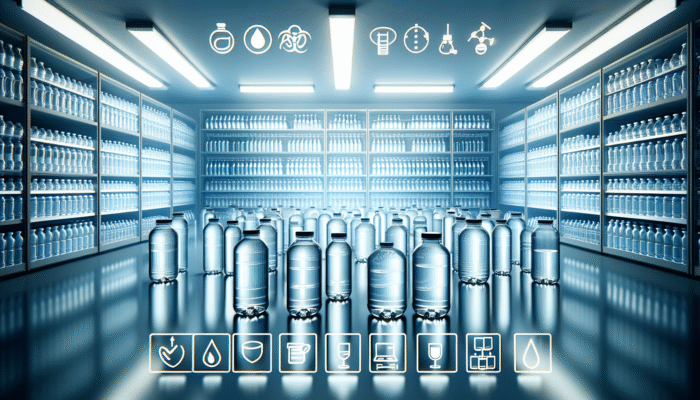Understanding the Vital Role of Emergency Water Reserves for Community Survival
Recognising the Urgent Need for Water Reserves in Times of Crisis

Emergency water reserves are indispensable for ensuring survival during crises when the availability of clean water is often severely compromised. Water is not merely a basic need for hydration; it is essential for upholding health standards and sanitation practices. In catastrophic events like floods or earthquakes that disrupt water supply systems, well-stocked reserves can be the crucial difference in saving lives. This issue is not just about quenching thirst; it is fundamentally linked to sustaining public health, preventing disease outbreaks, and bolstering community resilience during challenging times. The assurance of having access to safe drinking water can significantly impact recovery outcomes and survival rates in affected areas.
When disasters strike, the instinctive response of individuals is to seek potable water. In urban settings, a scarcity of accessible water can lead to panic and unrest, potentially spiralling into chaos. Therefore, communities that invest in establishing Emergency water reserves can effectively alleviate this chaos by ensuring immediate access to safe drinking water. This is particularly crucial in regions that are vulnerable to natural disasters; however, the need for such reserves has become increasingly apparent worldwide as the effects of climate change amplify extreme weather events. From drought-affected areas in sub-Saharan Africa to flood-prone coastal regions in Southeast Asia, one undeniable reality emerges: the availability of water is vital for survival.
Enhancing Preparedness Advantages Through Strategic Water Management Approaches
Preparedness extends beyond being a buzzword; it embodies a vital framework for protecting health and hygiene during emergencies. Consider a scenario where a hurricane threatens a coastal community. Those who take proactive measures to stock up on emergency water reserves can significantly reduce their risk of dehydration and avert health crises. As water supplies diminish and emergency services may become overwhelmed, those with access to reserved water can maintain hygiene practices that are essential for preventing disease outbreaks.
The advantages of preparedness also transcend individual health issues. Communities that prioritise the establishment of emergency water reserves can uphold high standards of sanitation, which reduces the risk of disease outbreaks, including cholera and typhoid fever, that thrive in unsanitary conditions. The adage rings true: prevention is worth more than cure. Equipping communities with the necessary resources to withstand adversity can save innumerable lives while fostering a culture of resilience and accountability that extends to all critical resources.
Establishing Long-Term Stability and Security Through Strategic Water Reserves
Long-term stability is not merely an abstract concept; it represents a concrete outcome for those who acknowledge and prioritise the establishment of emergency water reserves. These reserves serve as a protective buffer against the unpredictable consequences of climate change, which includes droughts, floods, and other water-related challenges. By investing in robust water storage solutions and strategically developing reserves, communities prepare not only for immediate emergencies but also create a foundation for enduring stability and resilience.
For instance, cities that deploy comprehensive water management strategies often see a notable decline in economic losses during crises. Agriculture, the backbone of numerous economies, flourishes when farmers have reliable access to water, even amid drought conditions. This creates a positive ripple effect, enhancing food security, economic stability, and fostering social cohesion. Preparing for potential water shortages is equivalent to paving the path towards a sustainable future, equipping communities to adapt and thrive in the face of multifaceted challenges.
Implementing Comprehensive and Effective Water Storage Solutions

Effectively storing water goes beyond merely filling tanks; it is both a science and an art. Successful strategies for emergency water reserves must incorporate methods that guarantee safety, accessibility, and usability. The selection of appropriate storage containers is paramount. Food-grade plastic or glass containers are ideal choices, as they prevent harmful chemicals from leaching into the water. Furthermore, routine inspections and adherence to established disinfection protocols are crucial in ensuring that stored water remains uncontaminated.
Innovative storage solutions are emerging globally, ranging from underground cisterns designed to capture rainwater in arid regions to advanced filtration systems that treat surface water for safe consumption. For example, in India, community-led initiatives are actively engaged in harvesting rainwater, creating sustainable solutions that aid in replenishing groundwater aquifers. As we examine these strategies, it becomes clear that effective water storage is not just about readiness; it involves harnessing our collective creativity and ingenuity to guarantee water safety and accessibility for all.
Encouraging Collaborative Efforts Between Communities and Governments in Water Management
Collaboration is the foundation of sustaining emergency water reserves. Individual actions alone are insufficient; a united effort between community members and government entities is critical for establishing effective water management systems. Governments play a vital role in creating supportive policies, funding necessary infrastructure, and promoting active participation within communities. When government bodies collaborate with local organisations, transformative results can be realised.
Consider successful models worldwide, such as community-led water management systems in Sweden. Here, local stakeholders actively monitor and maintain water reserves, fostering a sense of ownership and accountability. Conversely, in regions where government support is lacking, communities often struggle to develop effective reserves. The lesson is clear: collaboration amplifies resources and enhances trust and resilience within communities during crises.
Examining the Various Types of Emergency Water Reserves
Comprehending the Essential Role of Surface Water Storage in Emergency Situations
Surface water reserves, which encompass lakes, reservoirs, and ponds, play a crucial role in supplying communities with emergency water supplies. In circumstances where natural disasters disrupt conventional water supply chains, these bodies of water can serve as vital lifelines, provided they are adequately treated before use. For instance, indigenous communities in the Amazon rainforest depend on large rivers as sources of drinking water after thorough purification, illustrating how nature can act as a reservoir in critical situations.
The effective utilisation of surface water hinges on appropriate treatment methods. Technologies such as UV purification and advanced filtration systems are essential for ensuring that stored surface water is safe for consumption. In urban environments, several cities have adopted stormwater management systems that capture and treat rainwater runoff, transforming potential hazards into valuable resources. The global push for sustainability urges us to think creatively about harnessing available resources, thereby redefining our relationship with water.
Unlocking the Potential of Groundwater Reserves for Sustainable Utilisation
Groundwater is often a hidden treasure, critical for providing a reliable water supply during emergencies. Accessed through wells and boreholes, these reserves offer essential resources when surface water supplies are compromised. Countries like Ethiopia and India have historically relied on groundwater for agricultural and domestic use, underscoring its significance in everyday life.
However, the extraction of this valuable resource necessitates careful management. Over-extraction can lead to depletion, resulting in long-term water scarcity. Innovative practices, such as rainwater harvesting and recharge wells, can aid in replenishing groundwater supplies, ensuring these reserves remain viable for future emergencies. With a strategic approach, communities worldwide can leverage groundwater’s potential to promote sustainability and security.
Understanding the Significance of Bottled Water Stockpiles in Emergency Preparedness
The convenience and simplicity of bottled water stockpiles render them an essential component of emergency water reserves globally. Ready for immediate use, bottled water is an ideal solution for swift distribution to populations affected by emergencies. After disasters such as hurricanes or earthquakes, bottled water often becomes a highly sought-after commodity, frequently among the first supplies delivered to impacted areas.
Nonetheless, while bottled water offers immediate relief, it raises significant sustainability concerns. The environmental impact of plastic waste is a pressing issue that cannot be overlooked. Communities must strive to strike a balance between the benefits of bottled water and the urgent need to reduce plastic consumption. Exploring alternatives, such as refillable water stations during non-emergency periods, can help alleviate this problem. Innovative approaches, including biodegradable packaging or large-scale water purification stations, can ensure that bottled water remains a practical option without adversely affecting the environment.
Strategic Planning and Implementation for Effective Water Reserves
Assessing Community Water Requirements for Customised Reserve Strategies
Determining the water needs of a community is vital for establishing effective emergency water reserves. This process entails more than just counting the population; it involves calculating daily consumption needs and anticipating increased demand during emergencies. For example, an average individual in a temperate climate typically requires two to four litres of water daily for hydration, but this figure can double or triple in high-stress scenarios or hotter climates.
Effective assessments require collaboration with public health officials, community leaders, and disaster preparedness agencies to grasp what “normal” looks like for each community. For instance, communities located in drought-prone areas may require more substantial reserves compared to those situated in regions with consistent rainfall. By analysing historical data, water usage patterns, and potential future scenarios such as population growth or climate change, communities can formulate a customised water reserve strategy tailored to their specific situations.
Crafting a Comprehensive Water Reserve Strategy for Community Resilience
Developing a comprehensive water reserve plan is akin to designing a blueprint for community resilience. This process involves identifying potential water sources, determining optimal storage locations, and devising effective distribution methods to ensure efficient utilisation. A well-crafted strategy should integrate diverse sources—from surface water to groundwater and bottled supplies—ensuring that no single resource is exclusively relied upon.
Engaging stakeholders throughout the planning process is essential. Local governments, emergency services, community organisations, and residents should have a voice in shaping the plan. This collaborative input fosters a sense of ownership and accountability for the initiative’s success. Additionally, detailed contingency plans for various scenarios must be established, ensuring that when disaster strikes, response protocols are clear, efficient, and equitable.
Promoting Community Engagement and Educational Outreach for Water Preparedness
The successful implementation of emergency water reserves heavily relies on active community participation and education. When individuals comprehend the significance of water reserves, they are more likely to engage in planning and preparedness activities. Workshops, community meetings, and educational campaigns can significantly enhance awareness regarding the importance of water conservation and the critical role of emergency management.
Programs that actively involve community members in practical actions—such as constructing rainwater harvesting systems or coordinating bulk water storage initiatives—foster a sense of unity and purpose. In countries like Kenya, grassroots movements focused on water education have empowered communities to take charge of their local water resources, significantly boosting disaster preparedness. By nurturing a culture of awareness and involvement, communities can ensure that their water reserve systems are not only established but also resilient and effective.
Ongoing Maintenance and Management of Water Reserves for Optimal Functionality
Conducting Regular Inspections and Assessing Water Quality
The age-old adage “An ounce of prevention is worth a pound of cure” rings true when it comes to maintaining emergency water reserves. Regular inspections and water quality assessments are crucial for ensuring that reserves remain safe and usable during emergencies. Communities should establish a routine inspection schedule that evaluates both the physical storage facilities and the quality of the stored water.
Testing for contaminants, including bacteria, nitrates, or harmful chemicals, should occur at least once a year. In areas prone to flooding, more frequent testing may be necessary to promptly address potential contamination risks. Local health departments or environmental agencies can provide valuable resources and support for these testing initiatives. By prioritising regular maintenance and testing, communities can safeguard against the dangers of relying on contaminated water during emergencies.
Recognising the Significance of Preventive Maintenance in Water Management
Preventive maintenance is often the unsung hero of effective emergency water reserves. It is significantly more cost-effective to proactively maintain water storage facilities and equipment than to deal with the consequences of contamination or system failures later. Simple actions, such as ensuring proper sealing of water storage tanks, can prevent the entry of pollutants and debris.
Training volunteers or local officials on maintenance protocols can cultivate a culture of responsibility within the community. Scheduled maintenance activities—such as cleaning storage tanks, checking filtration systems, or repairing leaks—should be documented to ensure accountability. Fostering a culture of preventive maintenance instills confidence; when the time comes for communities to rely on their reserves, they can do so with peace of mind.
Implementing Effective Inventory Management Techniques for Water Supplies
Maintaining an efficient inventory management system for emergency water reserves is crucial for ensuring that supplies are readily available when required. This involves keeping an accurate count of bottled water stockpiles, monitoring expiration dates, and employing a first-in, first-out (FIFO) method to minimise waste. Regularly updating inventory records helps identify shortages and plan for timely replenishments.
Communities can leverage technology to streamline inventory management. Simple tracking software or mobile applications can automate notifications for restocking and testing schedules, enhancing overall efficiency. In larger urban areas, collaborating with local businesses can secure support and resources, bolstering inventory levels and improving operational efficiency. By prioritising effective inventory management, communities enhance their preparedness for emergencies, ensuring that resources are available when they are needed the most.
Streamlining Distribution and Access to Emergency Water Reserves
Establishing Efficient Distribution Systems for Water Supplies
In times of crisis, every moment counts, making the development of efficient distribution systems for emergency water reserves essential. Delays in delivering water to affected areas can exacerbate suffering and complicate recovery efforts. Communities must design and implement distribution plans that facilitate rapid delivery to those in need, particularly in densely populated or remote locations.
Utilising a mix of local volunteers and established delivery networks can optimise distribution efforts. For example, partnerships with local businesses or non-profits can help mobilise resources quickly. In urban environments, pre-determined distribution points can streamline access, ensuring that water reaches those in need without unnecessary delays. Efficient distribution not only saves lives but also reinforces public confidence in emergency response systems.
Ensuring Fair Access to Water Resources for All Community Members
Equitable access to emergency water reserves is fundamentally a matter of justice, especially during crises when disparities in access often become glaringly evident. Vulnerable populations typically encounter the most significant challenges in obtaining essential resources. To ensure that all community members receive the necessary support, planners must prioritise equity in their distribution strategies, guaranteeing that everyone, regardless of socioeconomic status, can access vital resources during emergencies.
Working alongside community organisations that understand the unique needs of marginalised groups can enhance equitable access. Regular engagement with these communities can lead to tailored solutions, such as mobile distribution units that reach isolated areas or specific outreach programs that address language barriers. In the aftermath of disasters, ensuring equitable access to water can serve as a lifeline for those often overlooked, underscoring the importance of inclusivity in crisis response.
Setting Up Emergency Water Stations for Convenient Access within the Community
Establishing emergency water stations in strategic locations can provide accessible points for water distribution during crises. These stations act as hubs where communities can gather essential drinking water, minimising the need for individuals to travel long distances when resources are scarce. Efficient placement of these stations—such as at community centres, schools, or places of worship—ensures individuals can access water with relative ease.
Communities should also consider deploying portable water stations that can be quickly set up in response to emergencies. These systems can be positioned based on specific needs and relocated as circumstances change. Training volunteers to manage these stations promotes community engagement while ensuring that water distribution operates smoothly and effectively. Emergency water stations can fundamentally transform how communities respond to crises, prioritising access to clean water for everyone involved.
Implementing Monitoring and Reporting Systems for Transparency and Accountability
To ensure the effectiveness and transparency of water distribution and access during emergencies, communities must establish robust monitoring and reporting systems. This involves collecting data on water usage, distribution patterns, and community feedback to continually refine operations. Technology plays a pivotal role in this process; mobile applications or online platforms can facilitate real-time tracking of water supplies and distribution efforts.
Involving residents in monitoring initiatives fosters a sense of accountability and community ownership. Regular reports can be shared with the public, demonstrating transparency in the distribution process and building trust within the community. By prioritising monitoring and reporting, communities can adapt to changing conditions, ensuring that their emergency water reserves remain effective and accessible for all.
Identifying Challenges and Crafting Solutions for Water Reserve Initiatives
Addressing Limited Resources and Funding for Water Reserve Programs
The challenge of limited resources and funding can significantly impede the establishment and maintenance of emergency water reserves. Frequently, communities find themselves competing for funding against other pressing needs, creating a challenging catch-22 situation. However, by pursuing grants, forming partnerships with local businesses, and engaging in community fundraising initiatives, they can effectively navigate these barriers.
Innovative financing models can also alleviate resource constraints. For instance, social impact bonds can attract private investment in public projects by linking returns to performance metrics. Additionally, utilising technology to optimise resource management can reduce costs and enhance overall efficiency. By creatively addressing funding and resource allocation, communities can establish robust water reserve systems, even in the face of limitations.
Overcoming Infrastructure and Logistics Challenges in Water Management
Infrastructure and logistics challenges can present significant obstacles when establishing emergency water reserves. To tackle these issues, communities must conduct thorough infrastructure assessments to identify gaps and weaknesses. This may involve evaluating existing water distribution networks, storage facilities, and transportation mechanisms to ensure they can adequately support emergency response efforts.
Planning for transportation logistics is also critical. In remote areas, all-terrain vehicles or drones can facilitate water delivery to hard-to-reach locations. Furthermore, collaborative efforts with local governments and disaster response organisations can streamline logistics management, ensuring a coordinated response. By proactively addressing infrastructure challenges, communities can bolster their preparedness and resilience when disasters occur.
Boosting Public Awareness and Community Support for Water Initiatives
Increasing public awareness and garnering community support are vital for the successful implementation of emergency water reserve programs. Without public buy-in, initiatives can falter, leaving communities vulnerable. Campaigns that highlight the critical importance of water conservation, storage, and emergency preparedness can galvanise community members to take proactive measures.
Engaging influencers and local leaders can amplify these messages, creating a ripple effect throughout the community. Educational initiatives, such as workshops and outreach programs, can empower residents to actively contribute. By prioritising public awareness and fostering community support, communities cultivate a culture of preparedness, ensuring that when emergencies arise, they are not merely ready—they are resilient.
Embracing Technological Innovations for Effective Water Management
Transforming Water Purification Technologies for Emergency Applications
Innovative water purification technologies are revolutionising our approach to emergency water reserves. In regions where clean water is scarce, portable purification systems can swiftly convert contaminated water into safe drinking water. Technologies such as solar purifiers or advanced filtration units provide sustainable solutions that are both accessible and effective.
For example, in disaster-affected areas, the rapid deployment of mobile purification units can ensure that communities have immediate access to clean water when they need it most. Furthermore, emerging technologies, such as graphene-based filters, promise breakthroughs in water treatment, potentially enhancing purification processes on a global scale. By embracing these innovations, communities can fortify their emergency water reserves and improve their overall resilience in the face of crises.
Common Questions About Emergency Water Reserves
What are emergency water reserves and why are they crucial?
Emergency water reserves are designated supplies of clean water specifically set aside for use during disasters or emergencies when regular sources become unavailable, ensuring community survival.
Why are emergency water reserves vital for communities during crises?
They guarantee access to safe drinking water in emergencies, help prevent dehydration, and maintain sanitation standards, ultimately saving lives in critical situations.
How can communities effectively prepare for potential water shortages?
Communities can prepare by assessing their specific water needs, developing comprehensive reserve plans, and actively involving residents in educational and preparedness initiatives.
What types of water reserves are available for communities?
Types include surface water storage (lakes and reservoirs), groundwater reserves (wells and boreholes), and bottled water stockpiles that provide immediate access during crises.
What actions can I take to contribute to local water reserve initiatives?
You can engage by volunteering for community water programs, advocating for funding and resources, and promoting sustainable water conservation practices within your community.
What are the benefits of community involvement in establishing water reserves?
Community involvement fosters a sense of ownership, accountability, and effective response during emergencies, significantly enhancing overall resilience and preparedness.
How frequently should water quality be tested in reserve systems?
Water quality should be tested at least annually, but more frequent testing is advisable in areas at risk of contamination due to flooding or other disasters.
In what ways can technology assist with the management of emergency water reserves?
Technology can aid in purifying water, optimising distribution systems, and monitoring supplies, ensuring effective management and accessibility during emergencies.
What strategies ensure equitable access to water distribution?
Equitable access strategies include collaborating with local organisations, ensuring distribution points are accessible to all community members, and tailoring approaches to meet the needs of marginalised groups.
What role do governments play in establishing water reserve systems?
Governments support these initiatives through policy creation, funding, and forming partnerships with local communities to build and maintain effective water reserve systems.
Join us on our journey on X!
The post Emergency Water Reserves: Essential Strategies appeared first on Survival Bite.
The Article Emergency Water Reserves: Key Strategies for Preparedness Was Found On https://limitsofstrategy.com



